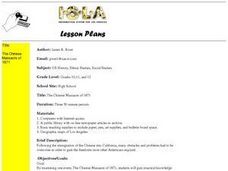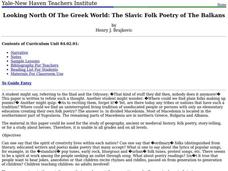Curated OER
The Chinese Massacre of 1871
Students investigate the historical Chinese Massacre of 1871. They conduct Internet research, analyze period maps of Los Angeles, read an article, design a timeline, and write a research paper.
Curated OER
U.S. Geography: The Northeast
Students investigate U.S. Geography by creating a map in class. In this natural resource lesson, students create a map of the United States and research the Northeast based on their resources and recyclable materials. Students...
Curated OER
My Community
Students identify how their school has changed. In this local community lesson, students listen to a brief history of their town and school and interview someone that graduated from their school. Students then create a map of their...
Curated OER
The Edge of the Lake
Second graders explore the geography of Nevada. In this map-making instructional activity, 2nd graders use salt dough to create a relief map of Nevada. Students label the landforms and bodies of water that are studied and specified in...
Curated OER
New England Colonies
Students study the New England colonies. In this colonies lesson, students use a directed reading-thinking method to learn about the New England colonies. Students follow the method to make predictions, read the text, and analyze the...
Curated OER
Partition of Africa Questions
In this colonial Africa activity, students study a map of Africa from 1885-1914. Students then respond to 9 short answer questions based on the information presented in the map.
Curated OER
Ridgerunner
Students jog at the beginning of the class while learning about the Appalachian Trail. They integrate math into the lesson by adding up how many miles they have run, and comparing it to distances on a real trail map.
Curated OER
The Byzantine Empire and the Rise of Russia
Eighth graders examine the Byzantine Empire and the rise of Russia. In this world history lesson, 8th graders complete a webquest that requires them to research the Hagia Sophia, Byzantine art, and Byzantine leadership.
Curated OER
Why Does Delaware Have Such A StrangeShape?
Students examine the events and history surrounding the boundaries of Delaware. They participate in a class discussion and analyze a map, then create a floor map using masking tape. Students also participate in a play about the...
Curated OER
End of the Line: What Happened to the Blue Ridge Railroad?
Sixth graders study the westward expansion and the role of railroad construction to the expansion. In this railroad history lesson, 6th graders complete KWL activity for the topic. Students view a PowerPoint about the growth of railroads...
Curated OER
Trading Traditions: Based on the American Samoa Quarter Reverse
Students investigate U.S. Currency by researching American Samoa. In this monetary unit lesson, students define the reverse and obverse of a coin while completing a currency related worksheet. Students identify American Samoa...
Curated OER
Stitching Truth Lesson Two: The Arpilleristas in Pinochet's Chile
Students analyze arpilleras. In this Chilean history instructional activity, students examine social justice issues as they read and interpret arpilleras. Students study the tapestries to learn about Augusto Pinochet and his human rights...
Curated OER
Primary and Secondary Documents for Colonial Times
Students investigate the Colonial Era by completing a template on their computers. In this U.S. History lesson, students discuss the differences between primary and secondary sources and identify several different sources as one or...
Curated OER
Milkweed and Monarch Quiz
In this milkweed and monarch butterfly worksheet, students take a quiz online about the milkweed and monarch butterflies. Students complete 10 multiple choice questions.
Curated OER
Kincora
In this Kincora worksheet, students read a passage about Kincora, answer short answer questions, draw a map, and made a model of the Feasting Hall. Students complete 4 activities.
Curated OER
Choices and Commitments: The Soldiers at Gettysburg
Learners investigate the Gettysburg Campaign and the major actions for each day of the battle. They read primary source documents, write a diary entry, analyze the Gettysburg Address, and write a persuasive speech regarding an issue in...
Curated OER
Signature History
Young scholars review the meaning and application of primary and secondary sources in research. They determine how researchers locate primary source documents before looking at signatures as a validating factor on many primary sources....
Curated OER
Looking North Of The Greek World: The Slavic Folk Poetry of The Balkans
Showing how folk poetry keeps alive national heritage is the stated goal of this proposal for a unit on the poetry of the Balkans.
Curated OER
The Persian Wars: Greece's Finest Hours
Maps and photographs help contextualize the Persian Wars in this straightforward presentation. These slides detail the motives and major events of the war between Persia and Greece, making it ideal for a lecture on ancient Greek politics...
Curated OER
The Brief American Pageant: The Great Depression and the New Deal
Experience the soaring highs and crashing lows of the 1920's and 1930's in this stark presentation. Though brief at eight slides (two are title slides), the graphs and maps would make a good accompaniment to your unit on the Great...
Curated OER
Making Sense of the Census
In this unit of lessons, young scholars make sense of the census. They examine why a census is taken and participate in activities.
Curated OER
Michigan's Early History
Students use maps and lecture notes to discover the diverse history of the state of Michigan. After gathering their information, students develop interview questions that might be used to interview an elderly person in their community.
Curated OER
Breaking News English: Map Shows Chinese Discovered America
In this English instructional activity, students read "Map Shows Chinese Discovered America," and then respond to 47 fill in the blank, 7 short answer, 20 matching, and 8 true or false questions about the selection.
Curated OER
1668 Map of Newark Activity
Eleventh graders read a map for historical information, decipher a map legend and symbols, and expand their knowledge of a historic time.























